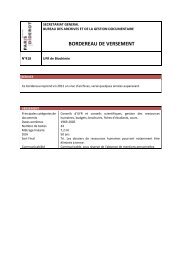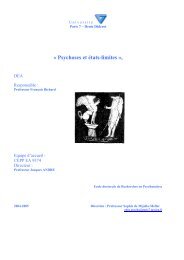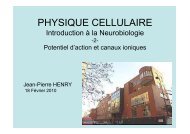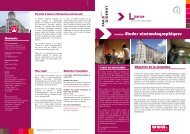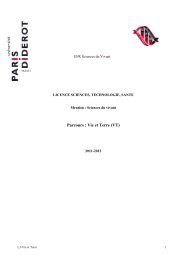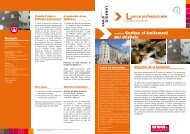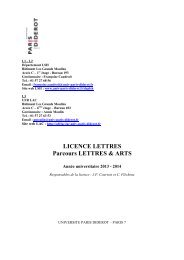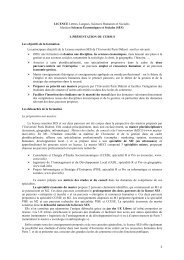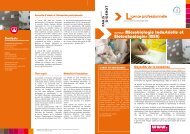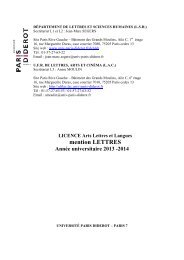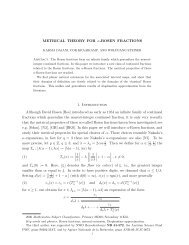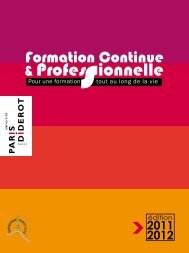Corpora for translator education and translation practice ...
Corpora for translator education and translation practice ...
Corpora for translator education and translation practice ...
You also want an ePaper? Increase the reach of your titles
YUMPU automatically turns print PDFs into web optimized ePapers that Google loves.
1.2. Challenges<br />
1.2.1. Educating educators<br />
It is common <strong>practice</strong> to speak of the instruction of future<br />
<strong>translator</strong>s as “<strong>translator</strong> training”. The term “training” implies<br />
that the abilities <strong>and</strong> competences to be learned are<br />
expected to be acquirable through <strong>practice</strong> with the kinds<br />
of tools <strong>and</strong> tasks one will be faced with during one’s future<br />
professional carreer, in an environment that reproduces<br />
as closely as possible the future work environment. Widdowson<br />
(1984) contrasts the training framework, in which<br />
learners are prepared to solve problems that can be identified<br />
in advance through the application of pre-set or “acquired”<br />
procedures, with the <strong>education</strong> framework, whose<br />
aim is to develop the ability to employ available knowledge<br />
to solve new problems, <strong>and</strong> to gain new knowledge as the<br />
need arises. According to Widdowson, LSP teaching would<br />
be an example of a training setting, while general language<br />
teaching would be an example of an <strong>education</strong>al setting.<br />
We may wonder whether <strong>translator</strong> <strong>education</strong> is in fact<br />
closer to the training or to the <strong>education</strong> end of the cline.<br />
Gouadec (2002, pp. 32ff) explicitly champions the <strong>for</strong>mer<br />
position:<br />
[W]e are supposed to train people to per<strong>for</strong>m<br />
clearly identified functions in clearly identified<br />
environments where they will be using clearly<br />
identified tools <strong>and</strong> “systems”. [...] No serious<br />
<strong>translator</strong> training programme can be dreamt<br />
of unless the training environment emulates the<br />
work station of professional <strong>translator</strong>s. [...]<br />
[T]he curriculum should [...] concentrate on emulating<br />
the actual work conditions of language<br />
services providers.<br />
These views are certainly not unusual, <strong>and</strong> indeed are rather<br />
popular with students <strong>and</strong> prospective employers, who often<br />
lament a limited role of technology in <strong>translator</strong> <strong>education</strong>.<br />
While I am obviously sympathetic to the general<br />
issue of technology in the <strong>translation</strong> classroom, I think it<br />
would be dangerous to carry these views to their extreme<br />
consequences, <strong>for</strong> two main reasons.<br />
First, if <strong>translation</strong> skills are best taught by simulating actual<br />
work conditions, we should ab<strong>and</strong>on the idea of <strong>education</strong><br />
<strong>for</strong> <strong>translator</strong>s (something that even Gouadec would<br />
probably not want to suggest) <strong>and</strong> turn to apprenticeship<br />
instead: a professional environment should arguably provide<br />
a more appropriate setting <strong>for</strong> the simulation of actual<br />
work conditions than an academic one. Second, <strong>and</strong> more<br />
importantly, actual work conditions - <strong>and</strong> time pressure in<br />
particular - require that <strong>translator</strong>’s strategies have become<br />
proceduralised, as is the case with mature professionals.<br />
Jääskeläinen (1997) finds that semi-professionals (<strong>translator</strong><br />
trainees) show more extensive processing than both professionals<br />
<strong>and</strong> non-professionals. She suggests that this<br />
may be because they are aware of the problems involved<br />
but have not yet automatised the necessary problem-solving<br />
strategies. Automatic processes are typically very efficient<br />
but little flexible, such that there is the danger, pointed out<br />
e.g. by Wills (1994, p. 144), “of problems being <strong>for</strong>ced into<br />
a certain structure, because it is believed to offer a solution”.<br />
In an <strong>education</strong> setting, students are still to develop<br />
the strategies that will then become proceduralised. Forcing<br />
them to work under realistic time constraints as would happen<br />
in a simulation activity could there<strong>for</strong>e work against<br />
the development of professionality.<br />
Translation instruction viewed as <strong>education</strong>, on the other<br />
h<strong>and</strong>, would make time <strong>for</strong> just the kind of activities <strong>and</strong><br />
reflections that future professional <strong>translator</strong>s will not have<br />
time <strong>for</strong>. A challenging aspect that is often neglected is how<br />
we can teach our students to identify problems in the first<br />
place. Going back to Gouadec (2002, p. 33), he claims that<br />
professional <strong>translator</strong>s should possess, among others, the<br />
following skills:<br />
1. Fully underst<strong>and</strong> material to be translated<br />
2. Detect, interpret <strong>and</strong> cope with cultural gaps [...]<br />
3. Transfer in<strong>for</strong>mation, facts, concepts [...]<br />
4. Write <strong>and</strong> rewrite<br />
5. Proofread<br />
6. Control <strong>and</strong> assess quality<br />
These skills translate into know-how; <strong>translator</strong>s should<br />
know how to:<br />
1. Get the in<strong>for</strong>mation <strong>and</strong> knowledge required<br />
2. Find the terminology<br />
3. Find the phraseology<br />
4. Translate<br />
5. Proofread<br />
6. Rewrite<br />
7. Manage their task(s)<br />
8. Manage a project (<strong>and</strong> other people)<br />
Comparing the two lists, one notices that neither item 1 nor<br />
item 2 in the first (the “skills” list) translate into any of the<br />
know-hows in the second. In other words, there is a gap between<br />
“fully underst<strong>and</strong> the material/detect any gaps etc.”<br />
<strong>and</strong> “getting the in<strong>for</strong>mation <strong>and</strong> knowledge required”.<br />
While illustrating this point with sufficient detail would<br />
take more space than is available here, a simple example<br />
can be provided. The phrases in the first column of Table<br />
2 are taken from the Time Out Barcelona Guide (2002,<br />
Penguin). They are all titles of short sections devoted to<br />
different events or places, <strong>and</strong> they all involve wordplay. In<br />
these cases, to “fully underst<strong>and</strong> the material to be translated”<br />
one needs to underst<strong>and</strong> the relationship between<br />
the facts being recounted or places being described <strong>and</strong> the<br />
lexicalised expressions used. While the texts themselves<br />
no doubt provide hints <strong>for</strong> getting at the more “congruent”<br />
sense, the less congruent sense is normally not as easily inferrable<br />
from the texts, since it is assumed to be available<br />
to the reader (this is in fact a precondition <strong>for</strong> the success of<br />
the wordplay). A student who is not aware of these layers



